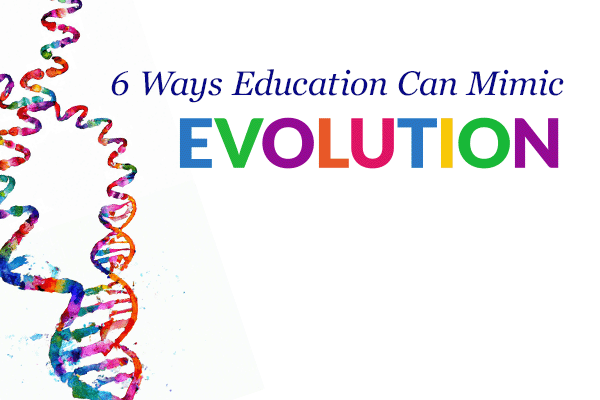Traditional and antique educational systems require their next evolution. Today, Learn Biomimicry asks: what can we learn from nature in how we create evolutionary education using biomimicry?
 The process of evolution is not a gold-standard one. Trial and error is the way. Credit: DALL-E-1, OpenAI
The process of evolution is not a gold-standard one. Trial and error is the way. Credit: DALL-E-1, OpenAI
1. Evolution never planned for greatness but achieved it anyway.
Education needs to adapt to changing conditions and evolve to survive.
How we think of objectives is misleading. The process of evolution is not a goal-oriented one. It does not have an end destination in mind or aims for an ‘A+’. The idea of a standardized curriculum, with standardized tests in standardized classes, thrived in an era of industrialisation. Our context has shifted radically. Education, like evolution, is better suited to following a process of trial and error, of experimentation and adaptation.
“When a measure becomes a target, it ceases to be a good measure.” – Goodhart’s Law
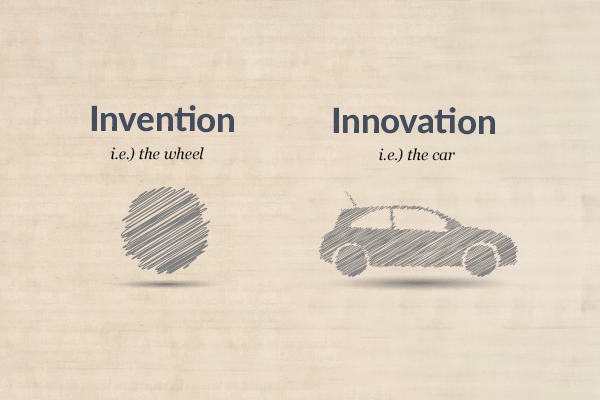 “Innovation is taking two things that exist and putting them together in a new way.” | Credit: Icons provided by Freepik
“Innovation is taking two things that exist and putting them together in a new way.” | Credit: Icons provided by Freepik
2. Our educational system needs innovation, not invention.
Institutions need to create feedback loops and replicate strategies that work.
It’s innovation, not invention, that drives humanity forward. Innovation is analogous to adaptation, while invention is analogous to mutation. A model worth emulating in our educational transformation is evolution. Improving our education system isn’t about starting from scratch but rather improving on what’s already working. Evolution is the ultimate learning algorithm. When we replicate strategies that work, we’re one step closer to practicing biomimicry. For example: create a feedback loop where the best biology teacher in Utah can share her strategy with teachers in California, in real-time. Importantly, it’s not necessarily the amount of improvement, but rather, the rate of iteration that matters.
 The rate of iteration matters. | Credit: JamesClear.com
The rate of iteration matters. | Credit: JamesClear.com
3. Evolution teaches us that the rate of iteration matters.
1% better every day leverages the power of tiny gains.
The approach to education hasn’t changed much in 100+ years. Standing still will get us nowhere fast. Each iteration is one more step along the endless path of advancing education. Advanced learning innovation begins when we increase the rate of iteration from annual cycles to monthly or even weekly cycles. Creating processes and systems that reshuffle information, and focus on the rate of iteration encourages exponential gains to be made.
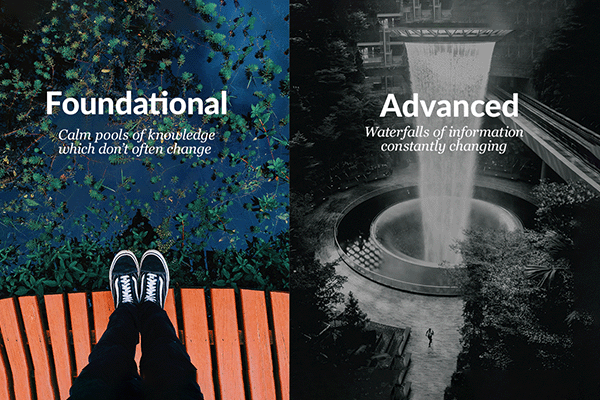 Knowledge pools: some pools are calm, and some pools are waterfalls.
Knowledge pools: some pools are calm, and some pools are waterfalls.
4. Evolution integrates development with growth.
Build from the bottom up with diversity, variation, redundancy and decentralization.
Not all knowledge or education is equal. Think of learning in pools—some pools are calm and don’t change, while others are cascading knowledge waterfalls of changing information all the time. Self-paced courses that are online and always on are well suited to sharing foundational knowledge. They’re still, calm, and don’t change much (only every year).
Advanced learning requires a different approach, with new information arising daily. Information which was once scarce is now abundant. No single lecturer or online course can adequately summarize all key information at the rapid pace of the internet. These waterfalls of cascading information call for ‘knowledge pods’ or co-learners to pool their resources, make sense of the information and adapt, self-organize, and share their learnings.
 The internet has changed everything. Living through the information revolution, it can be difficult to see how much things have changed.
The internet has changed everything. Living through the information revolution, it can be difficult to see how much things have changed.
Credit: DALL-E-2, OpenAi
5. Adapting to changing conditions can create educational freedoms.
Welcome to a permissionless and open-access world.
The right to education is a human right, and really, it’s indispensable. Educational freedom means accessible, permissionless, open access, the freedom to exchange, experiment, imagine, invest, and fail. The internet has changed everything. Living through the information revolution can be difficult to see how much things have changed—just the fact that a young girl in Kenya with access to the internet now has as much access to information as a researcher in the United Nations means the world has drastically changed. That statement wasn’t true just 15 years ago. Educational freedom begins when learning is online and accessible, permissionless and affordable.
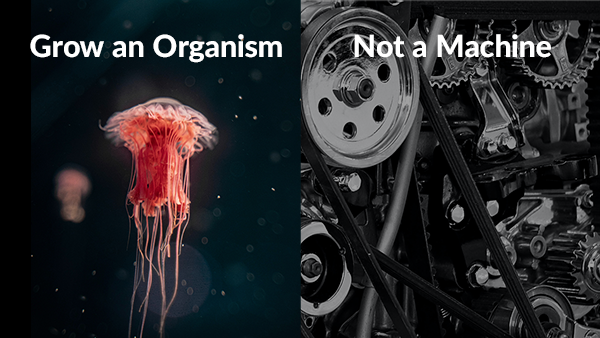 Creating conditions conducive to life starts with building organization that mimimc organisms.
Creating conditions conducive to life starts with building organization that mimimc organisms.
6. Evolution is about building an organism, not a machine.
In an increasingly changing world, it’s better to be adaptable than rigid.
Evolution is the original innovator, with organisms that incrementally change over time. Machines, when built—often (but not always) are well suited to repetitive tasks… with change now increasing exponentially our organizations need to be adaptable. Evolutionary innovation seeks incremental changes to existing products, processes, systems, and structures.
Today Learn Biomimicry is evolving to thrive. An inspiring life-friendly future exists when we envision a future where we learn from the genius of nature. All great innovations start with a seed. We planted ours in 2020. Since then, Learn Biomimicry has evolved to help more than +1,679 learners from over +41 countries practice biomimicry in their personal and professional lives. We’re focused on increasing our own rate of iteration on a 3-month improvement cycle.
Our organism is consistently evolving to provide a portal into and through the world of biomimicry. The world needs nature-inspired innovations, leaders, and organizations now more than ever. It’s time to think outside, in every sense, and learn biomimicry.
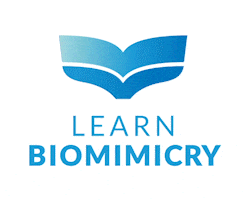 Learn Biomimicry is on a mission to make biomimicry education accessible and applicable, through our world-leading foundational short courses, Biomimicry Practitioner, and Educator programmes. By working with leading biomimicry practitioners, influential educators, and accomplished professionals, we’re here to professionally guide you into and through the world of biomimicry. The above article was written by Alistair Daynes.
Learn Biomimicry is on a mission to make biomimicry education accessible and applicable, through our world-leading foundational short courses, Biomimicry Practitioner, and Educator programmes. By working with leading biomimicry practitioners, influential educators, and accomplished professionals, we’re here to professionally guide you into and through the world of biomimicry. The above article was written by Alistair Daynes.

